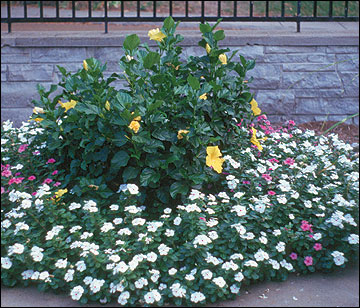Annual flowers are used primarily to brighten the landscape with abundant amounts of color. They are unsurpassed for adding interest to beds or borders or in pots or containers on the patio or deck. They may also be used for cut flowers, rock gardens, window boxes, hanging baskets, screens, temporary fillers and groundcovers.
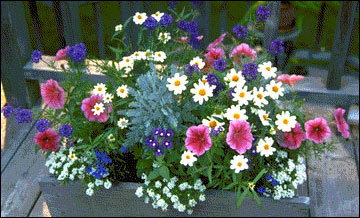
To brighten this deck, pink petunias, white zinnias and purple verbena are combined with the silvery foliage of dusty miller.
What is an "annual"?
The term "annual" when applied to herbaceous ornamentals refers to plants that are grown for only one season. A true annual completes its life cycle (bears seed) in one season and has an extended bloom span lasting (in most cases) throughout the summer. Some plants that we use like annuals in the garden actually are herbaceous perennial plants that bloom the first season but are unable to survive our winter climate. Other perennials are also used as annuals but display low or erratic winter survival rates (e.g., dianthus, dusty miller and mealy-cup sage). Thus, they are generally not dependable as perennials in colder climates.
Other "annuals" include certain tropical to semi-tropical woody plants that perform well in our area during the growing season but lack frost hardiness. Examples of the latter include tropical hibiscus and lantana.
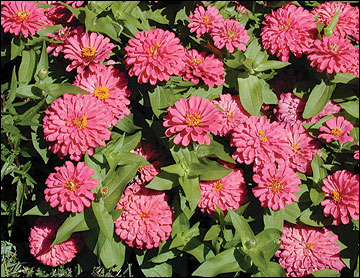
A true annual such as this zinnia is a plant that will grow from a seed, flower, produce seeds and die in one season. Zinnias provide a succession of flowers for summer color in any sunny location with good soil drainage.

Geraniums are nonhardy perennials that survive only one season in Missouri's climate.
Types of annuals
- Hardy annuals
Plants that tolerate cool temperatures and freezing conditions are termed hardy annuals. Pansy and snapdragon are good examples of this classification of annual plants. Such annuals may be planted for early spring color well before the frost-free date, or planted late in the summer for fall color. - Semi-hardy annuals
This group of annuals (e.g., petunia and calendula) can tolerate cool temperatures and a moderate frost (to about 28 degrees Fahrenheit.). These annuals may be planted slightly before the frost-free date for and area and will give extended color into the cooler days of fall.
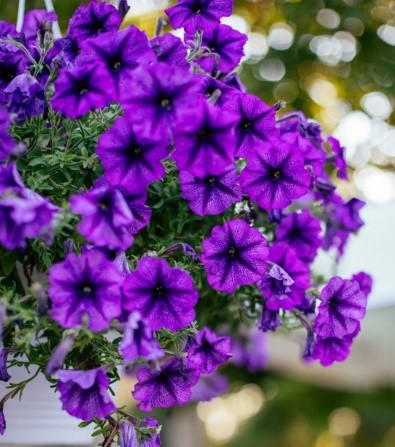
Petunia is an example of a half-hardy annual which, through plant improvement, has been developed to be fairly tolerant of hot weather.
- Tender annuals
Plants in this group do not tolerate cool weather and should not be planted until the danger of frost has past and the soil has warmed in spring. Vinca, marigold and zinnia are examples of annuals in this category.
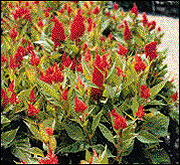 Plume celosia in only one of several types of celosia that provide summer decoration as well as flowers that may be dried for winter decoration.
Plume celosia in only one of several types of celosia that provide summer decoration as well as flowers that may be dried for winter decoration.
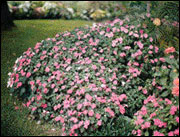 Impatiens are currently the most popular annual nationally and are unsurpassed for abundant flowers in a shady garden.
Impatiens are currently the most popular annual nationally and are unsurpassed for abundant flowers in a shady garden.
- What about biennials?
Although this guide is directed at plants used as annuals, a few other flowering plants called biennials (e.g., foxglove and sweet William) are used in conjunction with annuals. These plants require a certain amount of cool weather before flowers can form. In climates that are not too severe, they are planted in late summer or fall, survive the winter and flower the following season. After seed production, plants will die. In cold climates where winter survival of these plants is not dependable, they may be overwintered in cold frames and planted in the garden in early spring. Some may be seeded in cool greenhouses in winter and set into the garden in early spring, which may provide enough chilling for them to flower during the same season. Their culture in the garden is essentially the same as for most annuals.
Start seeds or buy plants?
The question often arises whether gardeners should buy started plants or grow their own. Starting seedlings indoors requires good light, proper temperature, a disease-free growing medium and adequate care. The gardener who does not have these conditions or who has limited time may best be advised to purchase started plants at a local nursery or garden center. Healthy, young plants that have been greenhouse grown provide a quick display of color. Cultivar selection usually is quite good at most progressive nurseries or garden centers. Look for plants that do not appear overly mature and pot-bound. The latter condition can delay new transplants from becoming established rapidly and lead to disappointing results.
Soil preparation
Soil destined for growing annuals should be dug or tilled deeply. Liberal amounts (up to 4 inches) of aged manure, compost or other organic matter should be worked into the soil as it is turned over. A complete fertilizer such as a 5-10-5 also may be scattered over the surface at a maintenance rate of about 1 to 2 pounds per 100 square feet before preparation. When soil fertility and acidity is unknown, a soil test should be made to determine need for lime and fertilizer.
If seeds are to be planted directly into the bed, the surface should be raked until lumps are broken up and a fine level seedbed is developed. If started plants are to be placed directly into the soil, small lumps may be allowed to remain. Always make sure that the surface is level, or slightly sloped toward the sides. Low spots encourage the development of disease because they remain too wet too long. If drainage is generally poor, the bed should be raised or drainage tile installed.
Most annual flowers grow and flower best in full sun. A few, however, are suitable for shade. For more specific light requirements see Table 1.
Seeding outdoors
After the seedbed has been prepared, make a shallow trench, scatter seeds thinly into it and cover very lightly. In heavy soils, cover small seeds with vermiculite or some other light material to prevent crusting. After planting, water the bed with a fine spray to avoid washing. The surface of the seedbed should be kept moist with daily light watering until germination is complete. If daily light watering is impossible, cover the rows with cloth, a thin layer of mulch or floating row cover. These covers must be removed promptly when germination begins. Daily light watering should be changed to heavier but less frequent watering as soon as seeds have germinated. Seedlings should be thinned before they become crowded; the final plant density varies according to species.
Setting started plants
Annual plants that have been purchased or started indoors may be planted outdoors when the season has reached the temperature preference for the species in question. Most avid gardeners are eager to start planting as early in the season as possible. While this is fine for some species of annuals that can tolerate cool temperatures, it is not suitable for others. Never try to "rush the season" by planting species before their desired date. Plants should be well watered at the time of planting and set at the same level that they were growing in the pots — never deeper. A cloudy day is best for transplanting. Untangling roots that are constricted and pot-bound before setting the plant in the soil is helpful in promoting quicker establishment. Tall, spindly plants should be pruned back to about one-half their original height before transplanting.
Newly set plants should be watered well and can be given a quicker start by applying a water-soluble, high-phosphorus starter fertilizer (e.g., 9-45-15) according to label directions. Spacing of flowering annuals in the bed or border is based upon the mature size of the species, which can be found in Table 1.
Table 1
Characteristics of various flowering annuals
| Common name (scientific name) |
Colors | Height | Light | When to plant | Comments |
|---|---|---|---|---|---|
| Ageratum (Ageratum houstonianum) |
Blue, lavender, purple, white | 1 to 18 inches | Full sun to semishade | Frost-free | Excellent low-growing plant. Trim off old flowers. |
| Amaranthus, Joseph's coat (Amaranthus sp.) |
18 to more than 36 inches | Full sun | Frost-free | Colored foliage. Suitable for poor soil. Heat and drought tolerant. | |
| Aster, China aster (Callistephus hybrids) |
Red, pink, blue, lavender, purple, white | 6 to 36 inches | Full sun | Spring outdoors | Good cut flower. Susceptible to several disease problems. Prefers cool temperatures. |
| Baby's breath, annual (Gypsophila elegans) |
Red, pink, white | 6 to 18 inches | Full sun | Frost-free | Masses of small white flowers in early summer. Prefers slightly alkaline soil. |
| Balsam, touch-me-not (Impatiens balsamina) |
Red, pink, blue, lavender, purple, white | 6 to 18 inches | Full sun | Frost-free | Likes abundant moisture and rich soil. Tends to reseed itself each year. |
| Begonia, tuberous begonia (Begonia x tuberhybrida) |
Red, pink, orange, yellow, blue, lavender, purple, white | 6 to 18 inches | Shade | Frost-free | Does not tolerate direct sun well. Excellent for shady locations. Cuttings root easily. |
| Begonia, wax-leaf begonia (Begonia semperflorens-cultorum) |
Red, pink, white | 6 to 18 inches | Full sun to semi-shade | Frost-free | Available in green- and bronze-leafed cultivars. Very floriferous. Provide afternoon shade in warm exposures for best performance. |
| Browallia (Browallia speciosa) |
Blue, lavender, purple, white | 6 to 18 inches | Full sun to semi-shade | Frost-free | Low-growing, bushy plant sometimes used for hanging baskets. Prefers cool temperatures. |
| Caladium (Caladium x hortulanium) |
Red, pink, white | 6 to 18 inches | Semi-shade to shade | Frost-free | Tolerant of shade but can stand full-sun if watered well. Colorful leaves. From tubers. |
| Calendula, pot marigold (Calendula officinalis) |
Orange, yellow | 6 to 18 inches | Full sun | Spring outdoors and frost-free | Flowers best in cool weather of spring and fall. |
| Canna (Canna x generalis) |
Red, pink, white | 6 to more than 36 inches | Full sun | Frost-free | Used for foliage effect and flowers. Heat tolerant. Available with green or bronze-leaves in several plant heights. From seeds or rhizomes. |
| Coleus (Coleus scutellarioides) |
Red, pink, orange, yellow, blue, lavender, purple, white | 6 to 18 inches | Full sun to semi-shade | Frost-free | Colorful foliage. Tolerates shade. Sun-tolerant types available from cuttings. |
| Cornflower, bachelor's button (Centurea cyanus) |
Red, pink, blue, lavender, purple, white | 6 to 36 inches | Full sun to semi-shade | Spring outdoors and fall outdoors | Most prolific bloom during early summer. Reseeds easily. |
| Cosmos, common (Cosmos bipinnatus) |
Red, pink, white | 18 to more than 36 inches | Full sun | Spring outdoors and frost-free | Highly dissected (lacy) foliage. Useful for cutting. Select early flowering cultivars. |
| Cosmos, yellow (Cosmos sulphureus) |
Orange, yellow | 18 to 36 inches | Full sun | Frost-free | Useful for cutting. Heat tolerant. May reseed. |
| Dahlia (Dahlia hybrids) |
Red, pink, orange, yellow, blue, lavender, purple, white | 6 to 36 inches | Full sun | Frost-free | Dwarf cultivars (border types) easily grown from seed. Exhibition types grown from root divisions. |
| Dianthus (Dianthus x hybrida) |
Red, pink, blue, lavender, purple, white | 1 to 18 inches | Full sun to semi-shade | Spring outdoors | Prefers cool temperatures. May survive winter, but best used as an annual. Prefers slightly alkaline soil. |
| Dusty Miller (Senecio cineraria) |
6 to 18 inches | Full sun | Spring outdoors | Grown for unique gray pubescent foliage. Half-hardy perennial. | |
| Flowering purslane (Portulaca oleracea ) |
Red, pink, orange, yellow, blue, lavender, purple | 6 to 36 inches | Full sun | Frost-free | Excellent heat and drought tolerance. Very colorful. Flowers close in late afternoon. |
| Four-o'clock (Mirabilis jalapa) |
Red, pink, orange, yellow, blue, lavender, purple, white | 18 to 36 inches | Full sun to semi-shade | Spring outdoors and frost-free | Flowers open in late afternoon. May self-seed. Can be used as temporary foundation plant. |
| Fuchsia (Fuchsia x hybrida) |
Red, pink, blue, lavender, purple | 6 to 18 inches | Semi-shade | Spring outdoors | Good plant for hanging baskets. Prefers cool temperatures. From cuttings. |
| Gaillardia (annual), blanket flower (Gaillardia pulchella) |
Red, pink, orange, yellow | 6 to 18 inches | Full sun | Frost-free | Smaller plants than perennial type. Flowers double or single. |
| Gazania, African daisy (Gazania rigens) |
Orange, yellow, blue, lavender, purple, white | 6 to 18 inches | Full sun | Frost-free | Needs well-drained sites. Excellent heat and drought tolerance. Exquisite flowers. |
| Geranium (Pelargonium x hortorum) |
Red, pink, blue, lavender, purple, white | 6 to 36 inches | Full sun | Frost-free | Double floret types from cuttings (cultured); single from seed (hybrid). Good container plant. |
| Globe amaranth (Gomphrena globosa) |
Red, pink, blue, lavender, purple, white | 6 to 18 inches | Full sun | Frost-free | Good heat and drought tolerance. Unique clover-like flower dries well. |
| Heliotrope (Heliotropium arborescens) |
Blue, lavender, purple | 18 to 36 inches | Full sun to semi-shade | Spring outdoors | Fragrant perennial plant grown as annual. Prefers cool temperatures. |
| Hibiscus, tropical hibiscus (Hibiscus rosa-sinensis) |
Red, pink, orange, yellow, white | 18 to 36 inches | Full sun | Frost-free | Tropical woody plant excellent for containers. Do not allow to dry out. From cuttings. |
| Hollyhock (Althaea rosea) |
Red, pink, orange, yellow, blue, lavender, purple | 6 to 18 inches | Full sun | Frost-free | Biennial often treated like an annual. Tolerates poor soil. Reseeds itself readily. |
| Impatiens, sultana (Impatiens wallerana) |
Red, pink, orange, yellow, blue, lavender, purple, white | 6 to 18 inches | Semi-shade to shade | Frost-free | Excellent for adding color to shady locations. Available in wide array of colors and heights. |
| Ivy-leaf geranium (Pelargonium peltatum) |
Red, pink, blue, lavender, purple | 1 to 18 inches More than 36 inches | Full sun | Spring outdoors | Prefers cool temperatures. Keep uniformly moist to avoid edema. Needs slightly acid soil. Good in containers. From cuttings. |
| Lantana (Lantana camara) |
Red, pink, orange, yellow, blue, lavender, purple | 18 to 36 inches | Full sun | Frost-free | Tender woody plant. Loves heat and sun. Good in containers. From cuttings. |
| Larkspur (Consolida ambigua) |
Red, pink, blue, lavender, purple, white | 18 to 36 inches | Full sun | Spring outdoors | Prefers cool temperatures. Sometimes slow to germinate. |
| Lobelia (Lobelia erinus) |
Blue, lavender, purple, white | 1 to 6 inches | Semi-shade | Spring outdoors | Excellent edging plant. Prefers cool weather. Available with vivid blue flowers. |
| Mandevilla, Brazilian jasmine (Mandevilla sanderi) |
Red, pink, white | More than 36 inches | Full sun | Frost-free | Tropical vine with large dark-pink flowers. Vigorous. From cuttings. |
| Marigold, African (Tagetes erecta) |
Orange, yellow | 6 to 36 inches | Full sun | Frost-free | Excellent heat tolerance. Easy to grow. Very reliable. |
| Marigold, French (Tagetes patula) |
Orange, yellow | 6 to 18 inches | Full sun | Frost-free | Excellent for edging. Tolerant of poor soils. Excellent heat tolerance. |
| Mealy-cup sage, blue sage (Salvia farinacea) |
Blue, lavender, purple, white | 18 to 36 inches | Full sun | Frost-free | Perennial plant treated as annual. Gray-green foliage highly aromatic. |
| Melampodium (Melampodium paludosum) |
Blue, lavender, purple | 6 to 36 inches | Full sun | Frost-free | Easy to grow. Nice balance of flowers to foliage. Excellent heat and drought tolerance. |
| Mexican heather (Cuphea hyssopifolia) |
Blue, lavender, purple | 6 to 18 inches | Full sun | Frost-free | Good heat and drought tolerance. Good for edging beds or borders. |
| Mexican sunflower (Tithonia rotundifolia) |
Orange, yellow | More than 36 inches | Full sun | Frost-free | Somewhat coarse. Taller types good for background. Good heat tolerance. |
| Moon flower (Ipomea alba) |
White | More than 36 inches | Full sun | Frost-free | Vigorous grower — needs tall support. Notch seeds before planting. |
| Morning glory (Ipomea tricolor) |
Red, pink, blue, lavender, purple, white | More than 36 inches | Full sun | Frost-free | A twining vine — needs support. Rapid grower. |
| Nasturtium (Tropaeolum majus) |
Red, pink, orange, yellow | 6 to 36 inches | Full sun to semi-shade | Frost-free | Tolerates poor soil. Dwarf, bushy types most useful. |
| New Guinea impatiens (Impatiens hawkeri) |
Red, pink, orange, yellow, blue, lavender, purple, white | 6 to 18 inches | Full sun to semi-shade | Frost-free | Larger flowers and more sun-tolerant than impatiens. Keep well-watered. From cuttings. |
| Nicotiana, flowering tobacco (Nicotiana alata) |
Red, pink, orange, yellow, blue, lavender, purple, white | 18 to 36 inches | Full sun to semi-shade | Spring outdoors | Flowers fragrant at night. Good heat tolerance. New, dwarf cultivars preferred. |
| Nierembergia, cupflower (Nierembergia caerulea) |
Blue, lavender, purple, white | 1 to 18 inches | Full sun to semi-shade | Spring outdoors | Compact plant for edging. Prefers cool temperatures. |
| Ornamental pepper (Capsicum annuum) |
Red, pink, orange, yellow, blue, lavender, purple | 6 to 18 inches | Full sun | Frost-free | Grown for brightly colored fruit. Heat tolerant. |
| Pansy (Viola x wittrockiana) |
Red, pink, orange, yellow, blue, lavender, purple, white | 1 to 18 inches | Full sun to semi-shade | Spring outdoors and fall outdoors | Tolerates frost and prefers cool temperatures. Newer cultivars more heat tolerant. |
| Petunia (Petunia x hybrida) |
Red, pink, orange, yellow, blue, lavender, purple, white | 6 to 18 inches | Full sun | Spring outdoors | Easily grown. Available in grandiflora, multiflora and doubled types in wide array of colors. Cultivars from cuttings especially floriferous with greater heat tolerance. |
| Phlox, annual (Phlox drummondi) |
Red, pink, blue, lavender, purple, white | 1 to 18 inches | Full sun | Frost-free | Easily grown. Good for edging. Vivid colors. Heat tolerant. |
| Plume celosia (Celosia plumosa) |
Red, pink, orange, yellow | 1 to 18 inches | Full sun | Frost-free |
Easily grown. Tolerant of heat and poor soils. Crested forms available as cockscomb. |
| Rose moss, portulaca (Portulaca grandiflora) |
Red, pink, orange, yellow, blue, lavender, purple, white | 1 to 6 inches | Full sun | Spring outdoors and frost-free | Easily grown. Popular for edging in dry, sunny locations. Excellent heat tolerance. |
| Salvia, scarlet sage (Salvia splendens) |
Red, pink, blue, lavender, purple, white | 6 to 36 inches | Full sun | Spring outdoors | Very colorful. Easy to grow. Available in different plant heights and novel new colors. |
| Scaevola, fan flower (Salvia splendens) |
Blue, pink, white | 6 to 24 inches | Full sun | Spring outdoors | Very heat tolerant. Unique fan-shaped flower. Shorter types good for edging. Taller types used in hanging baskets. |
| Snapdragon (Antirrhinum majus) |
Red, pink, orange, yellow, blue, lavender, purple, white | 6 to 36 inches | Full sun | Spring outdoors | Prefers cool temperatures. Dwarf types good for edging. Tall types good for cutting. |
| Spider flower, cleome (Cleome hasslerana) |
Red, pink, blue, lavender, purple, white | More than 36 inches | Full sun to semi-shade | Spring outdoors | Easy to grow. Often reseeds once established. Newer cultivars are said to have sterile flowers. |
| Statice (Limonium sinnuatum) |
Red, pink, orange, yellow, blue, lavender, purple, white | 6 to 18 inches | Full sun | Spring outdoors | Needs good drainage. Excellent for drying. |
| Strawflower (Bracteantha bracteatum) |
Red, pink, orange, yellow, blue, lavender, purple, white | 18 to 36 inches | Full sun | Frost-free | Excellent for drying. Cut before fully open. Do not over-water. |
| Sunflower (Helianthus annuus) |
Orange, yellow | More than 36 inches | Full sun | Frost-free | Easy to grow. Very heat tolerant. Several new colorful dwarf cultivars available. |
| Sweet alyssum (Lobularia maritima) |
Red, pink, blue, lavender, purple, white | 1 to 6 inches | Full sun to semi-shade | Frost-free | Excellent edging plant. Delightful sweet fragrance. Prefers cool temperatures. |
| Sweet pea (Lathyrus odorata) |
Red, pink, blue, lavender, purple, white | More than 36 inches | Full sun to semi-shade | Spring outdoors | Needs support. Prefers cool temperatures. Provide afternoon shade. Delightful fragrance. |
| Sweet William (Dianthus barbatus) |
Red, pink, blue, lavender, purple, white | 6 to 18 inches | Full sun | Spring outdoors and fall outdoors | Many flower first year; some biennial. May self-seed. |
|
Thungbergia, black-eyed Susan vine |
Orange, yellow | More than 36 inches | Full sun | Frost-free | Vigorous vine bearing gold-colored flowers with dark centers. Useful for baskets or trellises. |
| Torenia, wishbone flower (Torenia fournieri) |
Blue, lavender, purple, white | 6 to 18 inches | Semi-shade | Frost-free | Unique flower. Newer cultivars have improved heat tolerance. |
| Verbena (Verbena x hybrida) |
Red, pink, blue, lavender, purple, white | 1 to 18 inches | Full sun | Spring outdoors | Prefers cool temperatures. Available from seed or cuttings. Cutting types more heat tolerant. |
| Vinca, Madagascar periwinkle (Catharanthus roseus) |
Red, pink, blue, lavender, purple, white | 1 to 18 inches | Full sun | Frost-free | Excellent heat tolerance. Do not plant until soil has warmed in spring. Available in many colors. |
| Viola, tufted pansy (Viola cornuta) |
Red, pink, orange, yellow, blue, lavender, purple, white | 1 to 18 inches | Full sun to semi-shade | Spring outdoors and fall outdoors | Perennial often grown as annual. Tolerates more heat than pansy. |
| Zinnia, common (Zinnia elegans) |
Red, pink, orange, yellow, blue, lavender, purple, white | 1 to 36 inches | Full sun | Frost-free | Easy to grow. Excellent heat tolerance. Keep foliage dry to prevent powdery mildew. |
| Zinnia, creeping (Sanvitalia procumbens) |
1 to 6 inches | Full sun | Frost-free | Good annual groundcover for hot, dry location. Excellent heat tolerance. |
Maintenance
Annuals require about 1-1/2 inches of water per week during the height of the growing season. Infrequent but thorough watering is much preferred over light yet frequent watering. If overhead irrigation is practiced, water as early in the morning as possible to all foliage to dry quickly. Wet foliage promotes disease infestation.
In midsummer, when plants are flowering well, many annual species (e.g., petunia) benefit from a side-dressing of a fertilizer high in nitrogen (e.g., 34-0-0). Sprinkle the fertilizer lightly along the row, and water or gently incorporate it into the soil. If mulch was used, scatter the nitrogen fertilizer on the mulch and water it in. Avoid applying excess nitrogen to annuals, especially those that are not flowering. The result is likely to be lush vegetative growth and poor, delayed flowering.
Weed control is essential for attractive displays of annual flowering plants. The use of mulch or hand-cultivation can be effective in controlling weed populations and is the first line of defense against this problem. Organic mulches are especially beneficial in that they tend to enrich the soil as they break down over the summer. Mulches also help to curb water loss through evaporation from exposed soil. For those who wish to use chemical weed control, herbicides are available for use in annual beds and borders. Most herbicides labeled for use in annuals are preemergence in action. They should be applied after the annuals have been set but before any weed seeds have had time to germinate and emerge. Always read and follow label directions.
Removing spent flowers (deadheading) helps the floral display to appear more attractive and can stimulate a greater number of blooms. The process is time-consuming, however, and not necessary in all cases.
Insects and diseases
Prompt action for insect and disease control is important to maintain annuals in the best condition. Because of the many different annuals, we cannot list their individual pests here. Most have relatively few pests, but aphid, spider mite and insects with chewing mouthparts, such as grasshoppers, are the most problematic. Prompt action with a good, general-purpose insecticide or fungicide should remedy the condition. Many diseases thrive under crowded growing conditions, which tend to prevent leaves from drying quickly in the morning or after overhead watering. Vigorous plants, well-spaced for good air circulation, with good drainage and minimum shade usually have fewer disease problems.
Uses of annuals
- Beds and borders
Annuals typically are used in flowerbeds or borders to add interest and color to the landscape. In beds, annuals frequently constitute the entire planting, whereas in borders they add continuous summer color at or near the front of the border, which may contain perennials, ornamental grasses or even woody ornamentals. Additionally, annuals fill bare spaces and add color to dull areas. For example, when spring-flowering bulbs cannot be removed, annuals can be interplanted for cover after the bulbs.
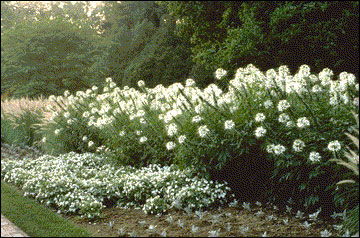
Used as a border, these white cleome create a very simple effect.
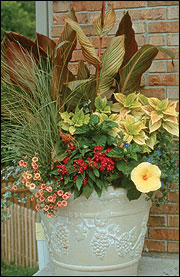 Containers and hanging baskets
Containers and hanging baskets
Selected annuals provide excellent color for containers and hanging baskets in sun or shade. Hibiscus, lantana, petunias, begonias, impatiens, geranium and verbena are examples of plants suitable for outdoor baskets or planters. Container production of annuals has several advantages, including the ability to create a more ideal root-zone environment. However, containers have limited growing medium which causes plants to dry rapidly on hot days. Daily watering may be necessary to prevent excessive drying and plant injury. Soil-less growing media comprised of peat, vermiculite and perlite are excellent for the container production of annuals.- Screens and hedges
Fast-growing annual vines such as morning glory and moonvine may be used for screens when trained on fences or trellises. Most annual vines climb by twining, so the support must contain wire or twine on which they can climb.
Other large, rapid-growing annual plants are suitable for large screens and hedges. Sunflowers and taller cultivars of cannas make colorful backgrounds. A lower hedge can be provided by melampodium, celosia or marigold.
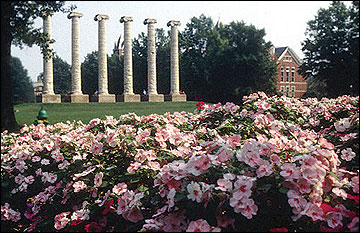 David Trinklein
David Trinklein